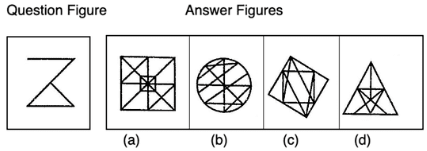Reasoning tests are used to test the logical thinking ability of the candidates and their skills to draw inferences. The reasoning tests have become an integral part of the competitive or entrance examinations. The reasoning questions asked in various examinations are difficult and need proper practice. For any candidate, solving different reasoning questions, including the embedded figure questions, becomes easy if the basic concepts behind these questions are understood well. The candidates have to get accurate answers within the stipulated time, which is only possible through consistent practice.
Why are reasoning tests important?
Logical reasoning tests are integral to the recruitment drives in banks, MNCs, software development firms, consulting firms, and others. Such reasoning tests are also crucial for competitive examinations such as IIT JEEs, Civil Services, CAT, GRE, GMAT, GATE, and others. The main objective behind conducting the logical reasoning tests, is to assess the interpretation, analysis, and problem-solving skills of a candidate. The reasoning tests are mainly categorised into verbal and non-verbal tests.
What is the Embedded Figures Test?
Embedded figures tests are the tests where figures are embedded inside another figure. In the embedded figure questions, a unique figure is embedded or hidden inside any of the four options provided in the answer.
All the options for these questions look confusing and the same. Hence, candidates likely make mistakes easily, or take lots of time to identify the correct answer to embedded figure questions.
But, with the knowledge of proper reasoning tricks and time management, candidates can master reasoning questions with embedded or hidden figures.
History of Embedded Figure Tests
The history of Embedded Figure Tests is almost five decades old. A pioneer in learning styles, Herman A. Witkin, did much research to develop learning style measures.
Every individual has a unique learning style. It is an individual’s way of perceiving, thinking, problem-solving, learning, and relating to others.
Witkin’s research revealed that different people perceive the discrete items within a surrounding space differently.
Witkin’s test results were measured on a scale where on one extreme end were the field-dependent learners, and on the other extreme end were the field-independent learners.
GEFT (Group Embedded Figures Test) was developed to quantify an individual’s learning style. The Embedded Figure Test is one way of measuring the intellectual development of an individual.
Types of embedded figures tests
There are various types of embedded figure tests.
Type1: Question Figure is embedded in the answer figure
In these embedded figure tests, a question figure is given along with four answer figures. The question figure is embedded or hidden in one of the given answer figures. The candidate has to find out the correct answer figure.
In some embedded figure test questions, the embedding of the question figure is not done directly in the answer figures. While answering these questions, the candidate must change the orientation of the question figure to get the correct answer.
Example 1: Find out the answer figure in which the given question figures is embedded.

The answer is (a) the question figure is embedded in the answer figure (a)
This is an example where the question figure is embedded in the answer figure, but its orientation is changed.
In some embedded figures tests, the question figure is hidden in two or more answers. In such questions, the candidates have to select the answer in which the question figure is hidden with the least change in the orientation.
Example 2: Choose the correct answer figure in which the question figure is embedded.

The answer is: (c) The question figure is embedded in the answer figure (c)
While selecting the answer, the vertical image of the question figure is considered not the horizontal image.
Type 2: Answer figure is embedded or hidden in the question figure
In such questions, one question figure and four answer figures are given. The candidate has to find out that answer figure, embedded in the question figure.
Example 3: Select the correct answer figure that is embedded in the question figure.

The answer is (a)
The answer figure (a) is hidden in the question figure.
Example 4: Select the correct answer figure that is embedded in the question figure.

The answer is (a) the figure in option (a) is embedded in the question figure.
Benefits of Embedded Figure Tests
For assessing the critical reasoning and problem solving ability of an individual.
For assessing the mathematical skill of an individual.
For assessing the social behaviour of an individual.
Conclusion
For any competitive exam, reasoning tests are the most important section. For a candidate, scoring good marks in reasoning tests helps get high scores. Reasoning tests may seem simple, but candidates need deep reasoning skills to solve them. Embedded figure questions constitute a very important part of the reasoning skills tests. Candidates can solve different types of reasoning questions accurately and fast if they know the correct tricks to do so. Whether the candidate is seeking a job or going for higher studies, logical reasoning is essential for assessing the candidate.
 Profile
Profile Settings
Settings Refer your friends
Refer your friends Sign out
Sign out










